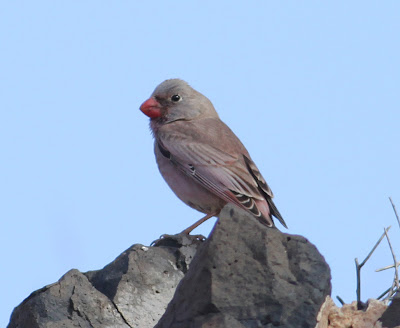I'm out of action. For today’s post I put together more archived material. This selection is from January 2013, a winter escape to Fuerteventura, just 60 miles from the coast of Morocco, North Africa.
Fuerteventura is the oldest Canary Island, formed about 70
million years ago as a result of volcanic activity. The geographical position
of Fuerteventura means that for many tens of thousands of years sand from the
Sahara has been deposited on Fuerteventura's shores, resulting in 125 miles of the world's finest beaches.
Beach Fuerteventura
Fuerteventura Beach
Little Egret
I volunteered to check out a few beaches for
waders and clocked up Kentish Plover, Ringed Plover, Turnstone, Sanderling, Whimbrel, Grey
Plover, Redshank, Greenshank, Bar-tailed Godwit and Curlew. Lots of Sandwich
Terns buzzed along the shoreline too, West Africa being a hot-spot for seeing the species.
Sanderling
Kentish Plover
Whimbrel
Sandwich Tern
Anyone planning a trip to Fuerteventura should be forewarned that the island is something of an exhibitionist paradise. Couples of all persuasions think nothing of walking hand in hand along the fine sand beaches.
Although holding a certain attraction, the beaches of Fuerteventura weren’t the sole interest of the holiday. A hire car for a few days gave a chance to explore the island although at approximately 650 square miles there’s a lot of ground to cover. A pure white car may not have been ideal for approaching cautious birds like Cream-coloured Courser, Stone Curlew or Houbara Bustard, the birds of the sandy plains.
Beach Bums, Fuerteventura
Although holding a certain attraction, the beaches of Fuerteventura weren’t the sole interest of the holiday. A hire car for a few days gave a chance to explore the island although at approximately 650 square miles there’s a lot of ground to cover. A pure white car may not have been ideal for approaching cautious birds like Cream-coloured Courser, Stone Curlew or Houbara Bustard, the birds of the sandy plains.
Fuerteventura
Over the Plains Fuerteventura
Cream-coloured Courser
Stone Curlew
Linnet
Desert Grey Shrike
Lesser Short-toed Lark
Egyptian Vulture
Fuerteventura January 2013
Inland birds and around the village of Betancuria proved to be Sardinian Warbler, Blackcap, Chiffchaff, Kestrel, African Blue Tit, Spectacled Warbler and Trumpeter Finch. The latter three were all new birds for me with the wary Trumpeter Finch a particular favourite, due to its slightly comical appearance.
Betancuria - Fuerteventura
Betancuria - Fuerteventura
Trumpeter Finch
A few Spectacled Warblers were in song, and we guessed the breeding season to be early in these parts.
Spectacled Warbler
The so named Canary Islands Stonechat Saxicola dacotiae is found only on Fuerteventura where it is said to frequent dried up river beds, the "barrancos", dotted around the island. I found them in a couple of locations where houses ran down to the beach, one time finding one feeding on the tide wrack with Berthelot’s Pipits. This endemic species is very like a very dark-headed Whinchat rather than a Stonechat but it has the chat like habits of both.
Berthelot's Pipit
Canary Islands Stonechat - CC-BY-2.0 via Wikimedia Commons
Fuerteventura
We enjoyed our single visit to Fuerteventura and Costa Calma, a large bay approximately 1.5 km long. Southwards it is possible to walk along the beach to Morro Jable for
approximately 21 km.
Costa Calma Hotel
In the quiet parts of the hotel grounds were Spanish
Sparrows, a pair of Hoopoes, the resident Kestrel and at least one White
Wagtail, following the gardener’s watering
hosepipe so as to locate insects. There were Blackcaps and
Chiffchaffs about the grounds but they kept out of sight in the strong sunshine
of most days.
Hoopoe
Spanish Sparrow
Kestrel
African Market, Costa Calma
As very birder knows, there’s a price to pay for a spot of
birding, brownie points to be earned and then banked for another day with bins
and camera. Here in Costa Calma it’s the “African” market where bartering is
the order of the day followed by a glass or two of wine reflecting on the
fading light and planning the day to come.
Fuerteventura






















































































